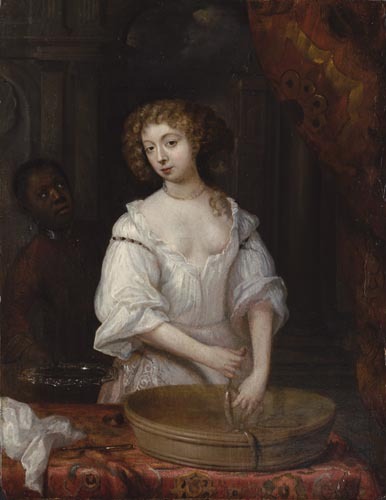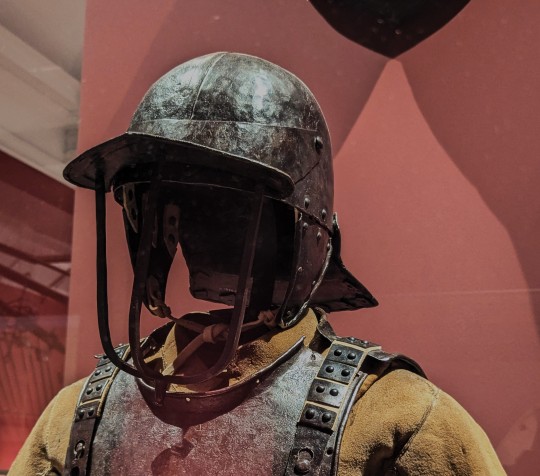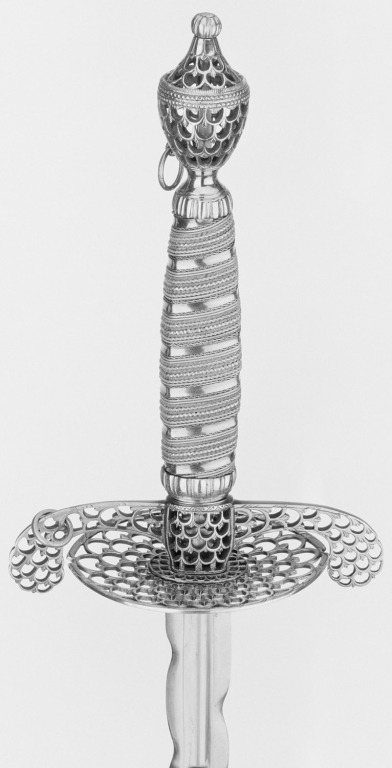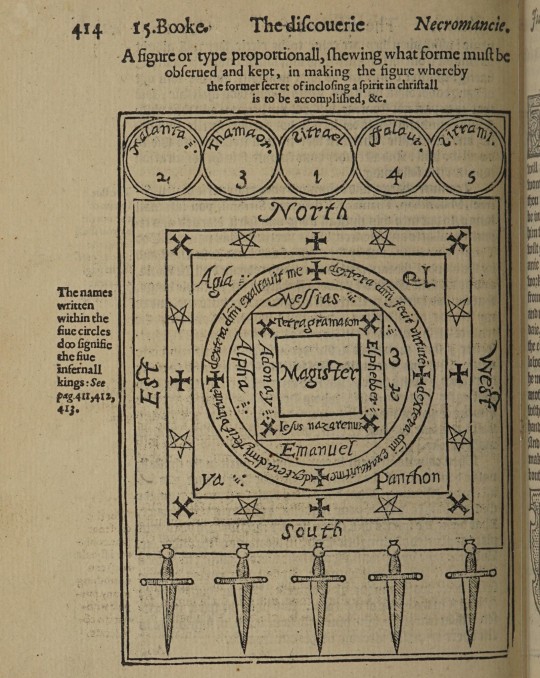#early modern England
Text
22 notes
·
View notes
Text

Nell Gwyn, mistress of Charles II, in virginial white handling some sausages.
Charles II was known for his saucy mistresses and the way he paraded them throughout court. His sex life was no secret, and sharp contrast to the Puritan values of the previous decades in England. This portrait, amongst others, is an example of how Charles treated his mistresses as important figures in the court, and Stuart court attitudes towards sex.
#nell gwyn#charles ii#charles ii of england#early modern#history#early modern england#english history#art history#stuarts#stuart england
105 notes
·
View notes
Text
Please promulgate so we may see everyone’s opinion on the Tudor Era Thomases (Henry VIII edition)
Also, take a shot for each Thomas on the list who was executed!
#the tudors#cromwell#Cranmer#Thomas more#Thomas Cromwell#Tudor era#history#Thomas Wolsey#cardinal Wolsey#henry viii#Tudor England#early modern period#early modern England#16th century
80 notes
·
View notes
Text


Selected images from “The Bute Book of Hours”.Above we spot Henry VII, King of England (1485-1509) with his wife, Elizabeth of York, Queen of England (1486-1503) praying with their offspring: Arthur, Prince of Wales (1486-1502), Margaret, Queen of Scots (1489-1541), Henry VIII (1491-1547) and Mary, Queen of France (1496-1533).
We also see Henry VI, King of England (1421-1471) portrayed as saint. Worth noting is that Henry VI was the main link to the Tudors (being the uncle to Henry VII), without whom there would be no dynasty to inherit the claim to English throne. Furthermore, Henry’s sainthood, despite unacknowledged by the Church (notwithstanding Henry VII’s efforts), was already sparkling in the twilight of Edward IV’s reign--much to his dismay as Lauren Johnson, Henry VI’s biographer, states. Yet, to be related to this saint king is also showing how God blessed the rise of a new dynasty. It is also said that Henry VIII was devoted to his great-uncle’s sainthood, in spite of all the reformation process that marked his reign.
This book of hours, probably produced in the last years of the reign of Henry VII, was later given to his son and sucessor, Henry VIII.
#the bute book of hours#tudor dynasty#plantagenet dynasty#house of lancaster#henry vii#henry viii#book of hours#early modern england#art#illuminated manuscript
62 notes
·
View notes
Text
Hilary mantel putting Walter Cromwell on absolute blast as a crook for watering down his ale when i promise you every brewer and/or seller in early modern England did that to some degree. I’d almost guarantee it
(Not shade at her btw it just tickled me. the poor sod in the afterlife all, ??????? Well id like to meet the bitch who didn’t)
#I mean there was#minimal regulation#is it any surprise most people took advantage at least a little bit?#watering it down#mixing different ale qualities#using unofficial measurements#some people were obviously worse than others but#this was standard practice!!#don’t hate the player hate the game#And on that note i will defend early modern women in this trade to the mat!! to the dirt!!#Wolf hall#Walter Cromwell#early modern#history#England#early modern England#history memes#history meme#Hilary Mantel
4 notes
·
View notes
Link
In the 1580s, the remote Essex village of St Osyth was beset by poverty and social tensions – and when a servant accused her neighbour of witchcraft, it sparked a crisis that engulfed the entire community. Speaking with Charlotte Hodgman, Marion Gibson explores what this late 16th-century witchcraft trial can tell us about life in early modern England.
#Elizabethan witchcraft: a trial that divided a community#history extra magazine#history extra podcast#history extra#history#witch trials#witches#witch hunt#witchcraft#Elizabethan#16th century#england#1500s#early modern#early modern England#british history#podcast#podcasts
3 notes
·
View notes
Text
I will never look at the Beggar's Opera the same way now that I know a bunch of those characters are based on RL queer people from the period.
In related news, Mother Clap's Molly House is some of the most charmingly written academic writing I've ever seen and the quality an extensiveness of the research is blowing me away. I wish I were rich because I'd love to buy a copy to have for myself, but even used copies are insanely expensive.
4 notes
·
View notes
Text

The Renaissance Beard: Masculinity in Early Modern England (2001) by Will Fisher
#early modern europe#gender history#excerpts#early modern england#16th century#17th century#renaissance#histblr#masculinity
0 notes
Text
Time Travel Question : Murder and Disappearance Edition I
Given that Judge Crater, Roanoke, and the Dyatlov Pass Incident are credibly solved, though not 100% provable, I'm leaving them out in favor of things ,ore mysterious. I almost left out Amelia Earhart, but the evidence there is sketchier.
Some people were a little confused. Edward V and Richard of Shrewsbury are the Princes in the Tower.
#Time Travel#Famous Murders#Jack the Ripper#La Bete du Gevaudan#Gandillon Family#Werewolves#William Rufus#King William II#Edward V#Richard of Shrewsbury#French History#English History#Early Modern Europe#Victorian England#Lord Darnley#Mary Queen of Scots#Scottish History#Amy Robsart#Lord Dudley#The Sodder Children#The Somerton Man#Australian History#Prime Minister Harold Holt#Elizabeth Short#The Black Dahlia
488 notes
·
View notes
Text




Harquebusier Armour from England dated to about 1680 on display at the Kelvingrove Art Gallery and Museum in Glasgow, Scotland
During the 17th century harquebusier cavalry were some of the most common in European armies. They were named after the carbine musket they used, the "harquebus" a shorter musket than the ones used by infantry. By 1680 though the Royal Scottish and English armies (later unified as the British Army) were converting these units in regiments of dragoons, mounted infantry who could also charge as cavalry. The armour was phased out of British cavalry regiments by the time of the 18th century.
Photographs taken by myself 2023
#armour#fashion#17th century#british empire#early modern period#england#english#military history#cavalry#kelvingrove art gallery and museum#glasgow#barbucomedie
111 notes
·
View notes
Photo


A flamberged Smallsword with a delicately pierced hilt,
OaL: 39.5 in/100.25 cm
Blade Length: 32.1 in/81.5 cm
England, ca. 1670-1787, housed with the Royal Collection Trust.
#weapons#sword#smallsword#europe#european#britain#british#england#english#early modern#royal collection trust#art#history
459 notes
·
View notes
Text
Wouldn't it just be delicious if in season 2 the show went out of its way to confirm Ed's literacy, like showing him casually doing captain things like looking at ship manifests or checking ledgers or whatever? I think that could be hilarious.
I'm already an Ed Can Read truther because beyond the likelihood that a captain would need to be able to read maps and charts and the like, the set for his cabin on his original ship included scrolls, and at the party we see him look at the dinner place card while sitting in the right place.
Also historically, it really wasn't that uncommon to be able to read but not write! So him signing with an X doesn't disprove that to me. It would be even funnier if later on we learned that he knew how to write properly too, or even had a lovely running hand that rivaled Lucius? I would just eat that up with a spoon.
#i cannot stress this enough#I mostly want this because it would be funny#like 99% of my desire for this is because it would be funny#anyway#literacy is a spectrum#something modern people forget because so many of us learn to read and write not that far apart#and do so fairly early in our lives#to say nothing of protestant attitudes towards literacy and how aggressively protestant England was#iirc the literacy rate in the colonies could be much higher at times because Puritans#which of course means more north america than anything#but idk#I'm willing to wait for the show to prove me wrong#edward teach is literate#only David Jenkins can judge me#I know people think it would be cute if we got a whole#stede teaches ed to read thing#but idk those plots in fics kinds gross me out#plus I think a show as obsessed with the stuff this one is wouldn't do that#ofmd#our flag means death#ofmd meta#edward teach
79 notes
·
View notes
Text

Was Anne of Cleves the luckiest?
Henry VIII's fourth wife, sometimes referred to as 'The Flanders Mare' is often forgotten about in comparison to the controversial Anne Boleyn and the ‘salacious’ Katherine Howard.
But was she the luckiest of the six wives?
She survived with her head and her dignity attached!
Was provided with three lavish manors to live a life of luxury
Was not forced to remarry
With the title of the King's 'good sister' and a substantial income from the crown she was able to relax, and live an extremely comfortable, independent life
All of this meant she answered to no man directly, and as a Tudor woman this is no small feat
#anne of cleves#tudors#henry viii#six#six wives#anne boleyn#history#early modern england#english history#british history#the tudors#tudor dynasty
49 notes
·
View notes
Text


Love this not at all biased opinion on English law in the 1460s and 70s. Granted, Fortescue was right in that English law was quite unique amongst monarchical countries in the 15th century as regards how it treated (and sought to curtail to a certain extent) monarchical powers.
#history of law#15th century#shardlake#for obvious reasons#history#early modern england#john fortescue
3 notes
·
View notes
Text

Magic circle from The Discoverie of Witchcraft by Reginald Scot, 1584, Wellcome Collection, London.
#magic circle#ritual magic#conjuration#demons#necromancy#nigromancy#occult#elizabethan england#early modern#16th century#conjuring spirits
344 notes
·
View notes
Text

The Buccleuch Collection miniature of Catherine of Aragon
#catherine of aragon#katherine of aragon#catalina de aragon#tudor history#henry viii#the tudors#english history#tudor era#tudor england#tudor period#tudor dynasty#house of tudor#16th century#16th century art#sixteenth century#reniassance#renaissance art#early modern#art#art history
14 notes
·
View notes